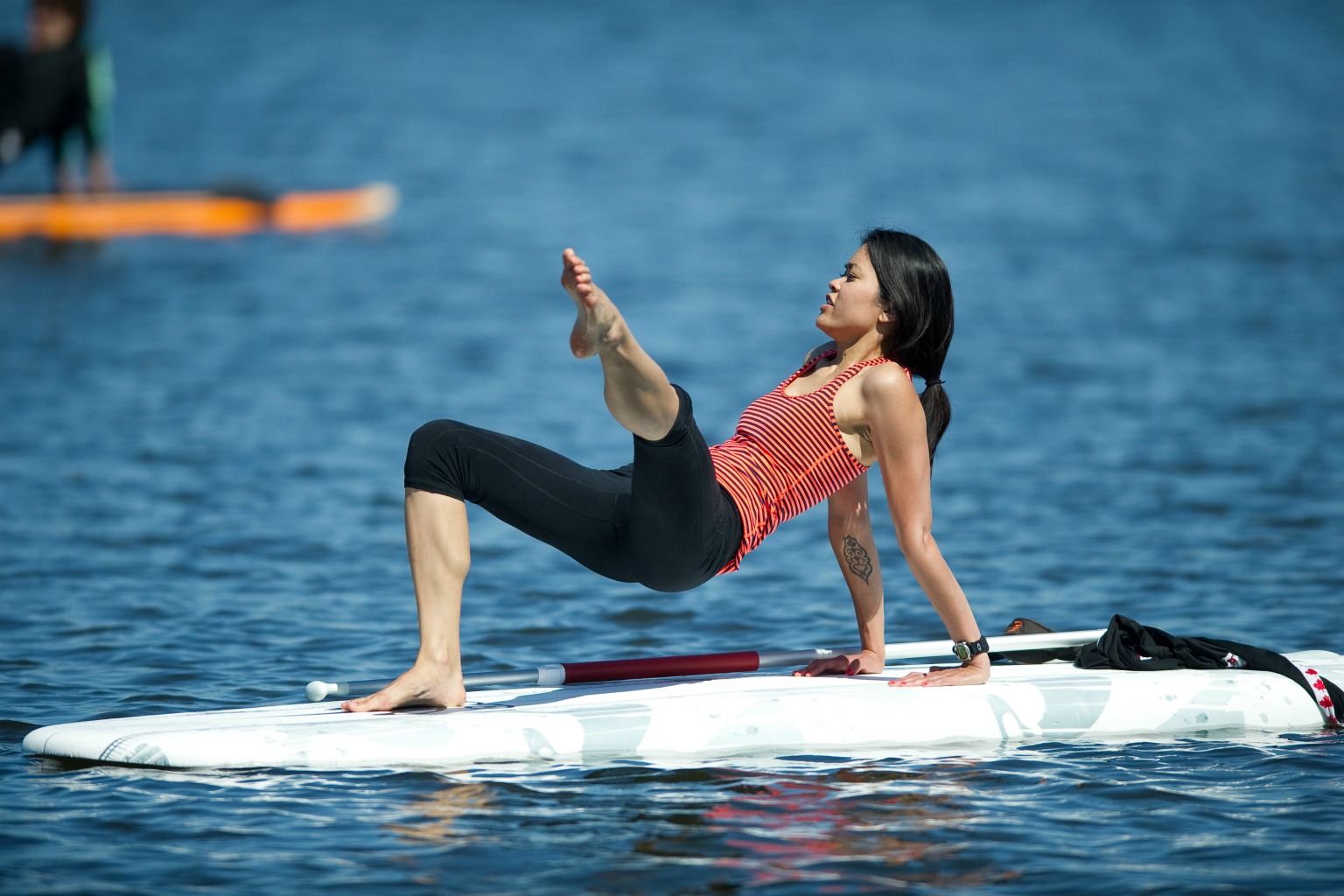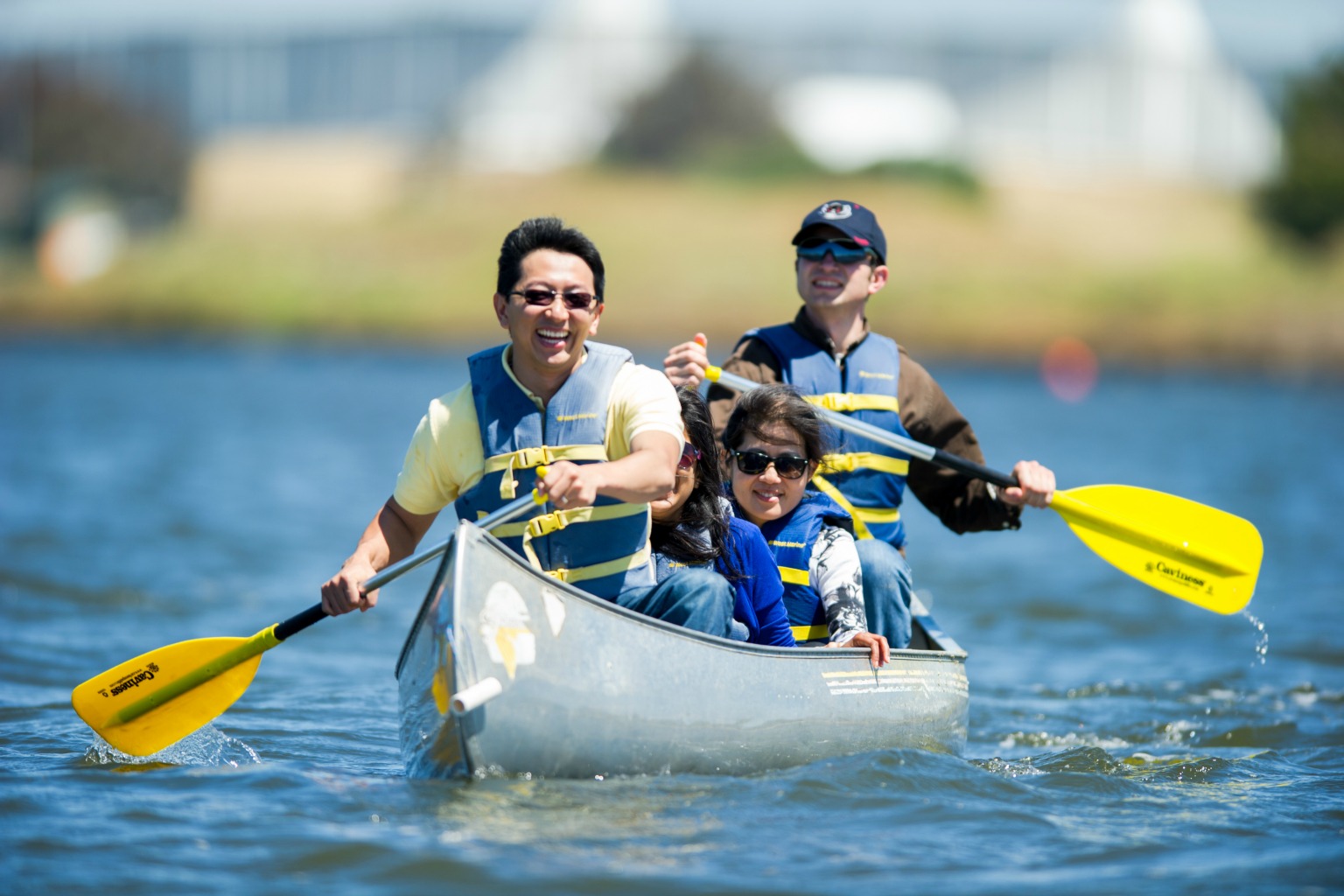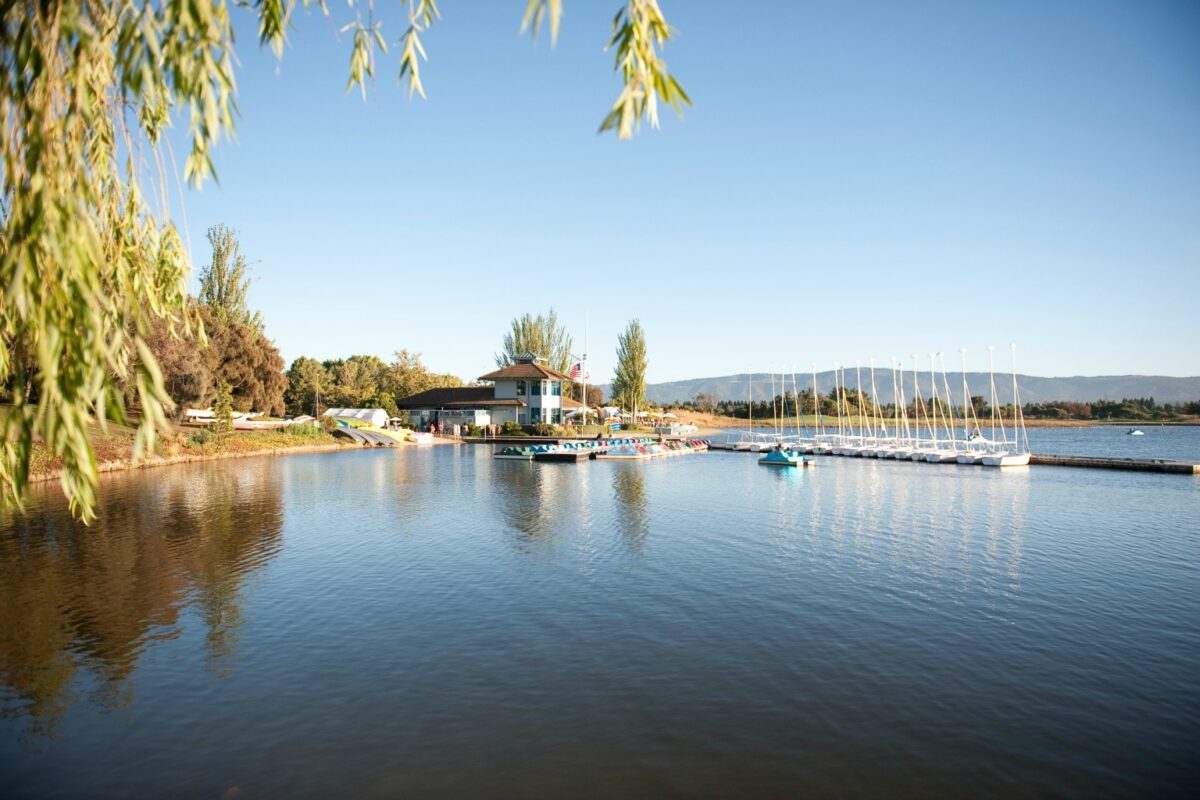The chilly, early-morning air makes me glad I’m wearing a long-sleeved rashguard. Or maybe the shivers are really nerves. I’ve never been on a stand-up paddleboard (SUP) before, much less practiced yoga on one of these floating mats. I keep reminding myself of the worst that could happen: falling in the water. Not so bad, right?
Our group gathers, sipping coffee and chatting about our different experience levels. Many have a long-standing yoga practice, while others are brand-new to yoga but have spent more time on the SUP. All of us feel a bit uncertain but willing to give it a shot, led by our upbeat, reassuring teacher. Boards and paddles in hand, we take a brief lesson on land before slowly making our way out onto Shoreline Lake.
Mountain View’s Shoreline Park opened to the public in 1983. Fifteen years earlier, these 544 acres were pretty much wasteland: a junkyard, flood plains, a hog farm and sewage treatment. Paddling out onto the 50-acre saltwater lake, it’s hard to imagine the lengthy process that created this serene public space. Only 300 yards from the San Francisco Bay, the lake is unaffected by tides; 22 hours a day, water is pumped in from the Charleston Slough, then pumped back out via Permanente Creek. Winds do pick up, though, enough for sailing and windsurfing. Despite the light breeze this morning, the water thankfully remains fairly calm; my wariness is the only thing rocking my board.
“Safety is absolutely first,” stresses Lisa Gaillant, who teaches at Shoreline and at Redwood City’s West Point Harbor (through Onboard SUP). “My philosophy is love over fear. Make sure that you are comfortable in something that scares you.” Lisa always takes time to ensure that every participant uses personal flotation devices correctly and a board leash when appropriate. It’s also critical, she says, to tether the boards to the buoys for safety. Once we click in, the SUPs become much more stable; the biggest trick is keeping the gentle waves from turning our boards into bumper cars. I certainly feel much steadier and more confident about this adventure.
Our class begins with a slow-flowing series of postures, testing our balance. Slower movements help us focus on engagement and stability, working the muscles much more than simply pushing through postures with momentum. We achieve some poses more easily on the board than first expected. Surprisingly, some postures easily attained on land make me certain I’ll fall in the water at any second. (None of us do.)

A flock of birds from the nearby sanctuary splash-lands near the edge of the lake. We lurk in a balancing tiger pose while a group of kayakers plays water basketball nearby. The park forbids swimming, fishing and motorized watercraft, and the birds seem oblivious to our presence.
As the morning grows warmer, more visitors arrive, rowing boats and paddling canoes rented on the dock. Dedicated in the early 1990s, the boathouse used to operate seasonally but has opened year-round since 2000, allowing for an expanded selection of lessons and rentals. Visitors can rent pedal boats, kayaks and canoes hourly, half-day or full-day; certified sailors can rent sailboats and windsurfers. (Lifejackets are free of charge.) The small retail shop sells sunscreen, towels, wetsuits, and other items perhaps forgotten at home.
After a final shoulder-stand and sun-soaked final relaxation pose, we stand up and begin paddling back to shore. In just an hour on the boards, we’ve transformed. A lot more laughter erupts from the group, and we joke about racing each other to shore, dodging various watercraft heading in our direction. Back on shore, we strike a tree pose for a final photo before heading to brunch at the lakeside American Bistro, watching others arrive for summer fun on the water.
Meanwhile, in the heart of Foster City, Leo J. Ryan Park has lured water sports aficionados for the past 14 years. (The park’s namesake, the congressman assassinated in the Jonestown Guyana massacre in 1978, served as a Navy submariner in the 1940s.) Though the breeze is too strong for SUP yoga, the park’s extensive, five-mile-long saltwater lagoon beckons windsurfers and paddlers from up and down the Peninsula. Protected from the Bay by a crescent of land, the lagoon has ideal weather and water conditions for curious beginners. The city allows swimming and licensed fishing in the lagoon. The park prohibits powerboating, making the space safer for water sports.
Decades-old California Windsurfing sits in a simple boathouse on the boardwalk alongside the lagoon. They provide lessons and equipment rentals for windsurfing, kayaking and stand-up paddleboarding. Pedal boat rentals cost $10 per ½ hour. As long as there’s an adult along, children are welcome. Remember to bring ID, as driver’s license or passport is required for watercraft rental, and note that only cash payment is accepted.

And perhaps the best way to cool off without a pool—get in the water. To repeat, there’s swimming in Foster City! In fact, it’s one of the few local spots where you can find sandy swimming beaches—with some of the cleanest water in the Bay Area. Look for large green patches of grass for picnicking, often with playgrounds for the kids. Marlin Park (Neptune Drive and Cringle Drive) offers 3.1 acres of sandy beach, and the sheltered cove cuts down on the breeze. And for hardier swimmers, set a summer goal for swimming across Central Lake in Leo J. Ryan Park.
Finally, in Redwood City, hit 101 Surf Sports to try out SUP, SUP yoga, windsurfing, kaying, outrigger canoeing and even surfskiing. They occasionally host fun, family-friendly paddling races for newbies and veteran racers alike.
hit the water
Shoreline Lake Boathouse, 3160 North Shoreline Boulevard, Mountain View. shorelinelake.com
California Windsurfing, 650 Shell Boulevard, Foster City. californiawindsurfing.com
101 Surf Sports, 101 Westpoint Harbor Road, Redwood City. 101surfsports.com


